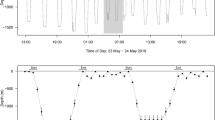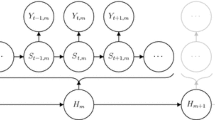Abstract
Recent years have seen a fast-growing body of literature concerned with the statistical modeling of animal movement in the two horizontal dimensions. On the other hand, there is very little statistical work that deals with animal movement in the vertical dimension. We present an approach that provides an important step in analyzing such data. In particular, we introduce a hidden Markov-type modeling approach for time series comprising the depths of a diving marine mammal, thus modeling movement in the water column. We first develop a baseline Markov-switching model, which is then extended to incorporate feedback and semi-Markovian components, motivated by the observations made for a particular species, Blainville’s beaked whale (Mesoplodon densirostris). The application of the proposed model to the beaked whale data reveals both strengths and weaknesses of the suggested modeling framework. The framework is general enough that we anticipate that it can be used for many other species given minor changes in the model structure.
Similar content being viewed by others
References
Altman, R. (2007), “Mixed Hidden Markov Models: an Extension of the Hidden Markov Model to the Longitudinal Data Setting,” Journal of the American Statistical Association, 102, 201–210.
Bailleul, F., Pinaud, D., Hindell, M., Charrassin, J.-B., and Guinet, C. (2008), “Assessment of Scale-Dependent Foraging Behaviour in Southern Elephant Seals Incorporating the Vertical Dimension: a Development of the First Passage Time Method,” Journal of Animal Ecology, 77, 948–957.
Baird, R. W., Webster, D. L., McSweeney, D. J., Ligon, A. D., Schorr, G. S., and Barlow, J. (2006), “Diving Behaviour of Cuvier’s (Ziphius Cavirostris) and Blainville’s (Mesoplodon Densirostris) Beaked Whales in Hawai’i,” Canadian Journal of Zoology, 84, 1120–1128.
Baird, R. W., Webster, D. L., Schorr, G. S., Mcsweeney, D. J., and Barlow, J. (2008), “Diel Variation in Beaked Whale Diving Behavior,” Marine Mammal Science, 24, 630–642.
Borchers, D. L., Zucchini, W., Heide-Jørgensen, M. P., Cañadas, A., and Langrock, R. (2013), “Using Hidden Markov Models to Deal with Availability Bias on Line Transect Surveys,” Biometrics. doi:10.1111/biom.12049.
Codling, E. A., Plank, M. J., and Benhamou, S. (2008), “Random Walk Models in Biology,” Journal of the Royal Society Interface, 5, 813–834.
Cox, T. M., et al. (2006), “Understanding the Impacts of Anthropogenic Sounds on Beaked Whales,” Journal of Cetacean Research and Management, 7, 177–187.
D’Amico, A., Gisiner, R. C., Ketten, D. R., Hammock, J. A., Johnson, C., Tyack, P. L., and Mead, J. (2009), “Beaked Whale Strandings and Naval Exercises,” Aquatic Mammals, 35, 452–472.
Dowd, M., and Joy, R. (2011), “Estimating Behavioral Parameters in Animal Movement Models Using a State-Augmented Particle Filter,” Ecology, 92, 568–575.
Guédon, Y. (2003), “Estimating Hidden Semi-Markov Chains from Discrete Sequences,” Journal of Computational and Graphical Statistics, 12, 604–639.
Harris, K. J., and Blackwell, P. G. (2013), “Flexible Continuous-Time Modelling for Heterogeneous Animal Movement,” Ecological Modelling, 255, 29–37.
Higgs, M. D., and Ver Hoef, J. M. (2012), “Discretized and Aggregated: Modeling Dive Depth of Harbor Seals from Ordered Categorical Data with Temporal Autocorrelation,” Biometrics, 68, 965–974.
Holzmann, H., Munk, A., Suster, M., and Zucchini, W. (2006), “Hidden Markov Models for Circular and Linear-Circular Time Series,” Environmental and Ecological Statistics, 13, 325–347.
Hooker, S. K., Baird, R. W., and Fahlman, A. (2009), “Could Beaked Whales Get the Bends?: Effect of Diving Behaviour and Physiology on Modelled Gas Exchange for Three Species: Ziphius Cavirostris, Mesoplodon Densirostris and Hyperoodon Ampullatus,” Respiratory Physiology & Neurobiology, 167, 235–246.
Houser, D. S. (2006), “A Method for Modeling Marine Mammal Movement and Behavior for Environmental Impact Assessment,” IEEE Journal of Oceanic Engineering, 31, 76–81.
Langrock, R. (2012), “Flexible Latent-State Modelling of Old Faithful’s Eruption Inter-Arrival Times in 2009,” Australian & New Zealand Journal of Statistics, 54, 261–279.
Langrock, R., and Zucchini, W. (2011), “Hidden Markov Models with Arbitrary Dwell-Time Distributions,” Computational Statistics & Data Analysis, 55, 715–724.
Langrock, R., King, R., Matthiopoulos, J., Thomas, L., Fortin, D., and Morales, J. M. (2012), “Flexible and Practical Modeling of Animal Telemetry Data: Hidden Markov Models and Extensions,” Ecology, 93, 2336–2342.
Langrock, R., Borchers, D. L., and Skaug, H. J. (2013), “Markov-Modulated Nonhomogeneous Poisson Processes for Modeling Detections in Surveys of Marine Mammal Abundance,” Journal of the American Statistical Association. doi:10.1080/01621459.2013.797356.
McCarthy, E., Moretti, D., Thomas, L., DiMarzio, N., Morrissey, R., Jarvis, S., Ward, J., Izzi, A., and Dilley, A. (2011), “Changes in Spatial and Temporal Distribution and Vocal Behavior of Blainville’s Beaked Whales (Mesoplodon Densirostris) During Multiship Exercises with Mid-Frequency Sonar,” Marine Mammal Science, 27, E206–E226.
McClintock, B. T., Russell, D. J. F., Matthiopoulos, J., and King, R. (2013), “Combining Individual Animal Movement and Ancillary Biotelemetry Data to Investigate Population-Level Activity Budgets,” Ecology, 94, 838–849.
Morales, J. M., Haydon, D. T., Frair, J. L., Holsinger, K. E., and Fryxell, J. M. (2004), “Extracting More Out of Relocation Data: Building Movement Models as Mixtures of Random Walks,” Ecology, 85, 2436–2445.
Patterson, T. A., Basson, M., Bravington, M. V., and Gunn, J. S. (2009), “Classifying Movement Behaviour in Relation to Environmental Conditions Using Hidden Markov Models,” Journal of Animal Ecology, 78, 1113–1123.
R Core Team (2012), R: a Language and Environment for Statistical Computing, Vienna: R Foundation for Statistical Computing. URL: http://www.R-project.org/.
Ramsay, J. O. (1988), “Monotone Regression Splines in Action,” Statistical Science, 3, 425–461.
Schick, R. S., Loarie, S. R., Colchero, F., Best, B. D., Boustany, A., Conde, D. A., Halpin, P. N., Joppa, L. N., McClellan, C. M., and Clark, J. S. (2008), “Understanding Movement Data and Movement Processes: Current and Emerging Directions,” Ecology Letters, 11, 1338–1350.
Schliehe-Diecks, S., Kappeler, P. M., and Langrock, R. (2012), “On the Application of Mixed Hidden Markov Models to Multiple Behavioural Time Series,” Interface Focus, 2, 180–189.
Tyack, P. L., Johnson, M., Aguilar de Soto, N., Sturlese, A., and Madsen, P. T. (2006), “Extreme Diving of Beaked Whales,” Journal of Experimental Biology, 21, 4238–4253.
Tyack, P. L., Zimmer, W. M. X., Moretti, D., Southall, B. L., Claridge, D. E., Durban, J. W., Clark, C. W., D’Amico, A., DiMarzio, N., Jarvis, S., McCarthy, E., Morrissey, R., Ward, J., and Boyd, I. (2011), “Beaked Whales Respond to Simulated and Actual Navy Sonar,” PLoS ONE, 6, e17009.
van der Hoop, J. M., Vanderlaan, A. S. M., and Taggart, C. T. (2012), “Absolute Probability Estimates of Lethal Vessel Strikes to North Atlantic Right Whales in Roseway Basin, Scotian Shelf,” Ecological Applications, 22, 2021–2033.
Walker, C. G., MacKenzie, M. L., Donovan, C. R., Kidney, D., Quick, N. J., and Hastie, G. D. (2011), “Classification of Animal Dive Tracks Via Automatic Landmarking, Principal Components Analysis and Clustering,” Ecosphere, 2, 92.
Yackulic, C. B., Blake, S., Deem, S., Kock, M., and Uriarte, M. (2011), “One Size Does Not Fit All: Flexible Models Are Required to Understand Animal Movement Across Scales,” Journal of Animal Ecology, 80, 1088–1096.
Zucchini, W., and MacDonald, I. L. (2009), Hidden Markov Models for Time Series: an Introduction Using R, London: Chapman & Hall.
Zucchini, W., Raubenheimer, D., and MacDonald, I. L. (2008), “Modeling Time Series of Animal Behavior by Means of a Latent-State Model with Feedback,” Biometrics, 64, 807–815.
Author information
Authors and Affiliations
Corresponding author
Electronic Supplementary Material
Below is the link to the electronic supplementary material.
Rights and permissions
About this article
Cite this article
Langrock, R., Marques, T.A., Baird, R.W. et al. Modeling the Diving Behavior of Whales: A Latent-Variable Approach with Feedback and Semi-Markovian Components. JABES 19, 82–100 (2014). https://doi.org/10.1007/s13253-013-0158-6
Received:
Accepted:
Published:
Issue Date:
DOI: https://doi.org/10.1007/s13253-013-0158-6




